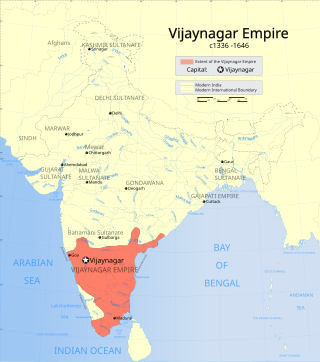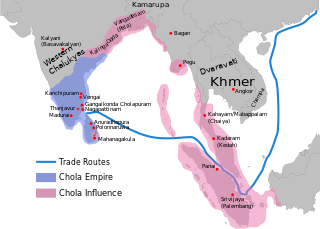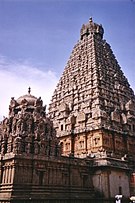
The Vijayanagara Empire was a medieval Hindu empire that ruled much of southern India. It was established in 1336 by the brothers Harihara I and Bukka Raya I of the Sangama dynasty, members of a pastoralist cowherd community that claimed Gadaria (Shepherd)lineage.

The Pandyan dynasty, also referred to as the Pandyas of Madurai, was an ancient Tamil dynasty of South India, and among the four great kingdoms of Tamilakam, the other three being the Pallavas, the Cholas and the Cheras. Existing since at least the 4th to 3rd centuries BCE, the dynasty passed through two periods of imperial dominance, the 6th to 10th centuries CE, and under the 'Later Pandyas'. Under Jatavarman Sundara Pandyan I and Maravarman Kulasekara Pandyan I, the Pandyas ruled extensive territories including regions of present-day South India and northern Sri Lanka through vassal states subject to Madurai.

The Chola dynasty was a Tamil dynasty originating from southern India. At its height, it ruled over the Chola Empire, an expansive maritime empire. The earliest datable references to the Chola are from inscriptions dated to the 3rd century BCE during the reign of Ashoka of the Maurya empire. The Chola empire was at its peak and achieved imperialism under the Medieval Cholas in the mid-9th century CE. As one of the Three Crowned Kings of Tamilakam, along with the Chera and Pandya, the dynasty continued to govern over varying territories until the 13th century CE.

Parantaka Chola I was a Chola emperor who ruled for forty-eight years, annexing Pandya by defeating Rajasimhan II and in the Deccan won the Battle of Vallala against Rashtrakutas which happened before 916 CE. The best part of his reign was marked by increasing success and prosperity.
Parantaka II was a Chola emperor. He is also known as Sundara Chola as he was considered an epitome of male beauty. He was the son of Arinjaya Chola and queen Kalyani, a princess of Vaidumba family. Parantaka II ascended the Chola throne despite the fact that his cousin Madurantaka Uttama Chola, the son of Gandaraditya Chola was alive and he had equal if not more claim to the Chola throne. During his reign, Parantaka Sundara Chola defeated the Pandyas and Ceylon and then recaptured the Tondaimandalam from Rashtrakutas.

The Chola Empire, which is often referred to as the Imperial Cholas, was a medieval Indian, thalassocratic empire that was established by the Chola dynasty that rose to prominence during the middle of the ninth century and united southern India under their rule.

Rajaraja II was a Chola emperor who reigned from 1150 to 1173. He was made his heir apparent and Co-Regent in 1146 and so the inscriptions of Rajaraja II count his reign from 1146. Rajaraja's reign began to show signs of the coming end of the dynasty.
The 'Chola Government during the imperial period in 850 – 1200 CE was marked for its uniqueness and innovativeness. Cholas were the first dynasty who tried to bring the entire South India under a common rule and to a great extent succeeded in their efforts. Although the form and protocols of that government cannot be compared to a contemporary form of government, the history of the Chola empire belongs to a happy age in history and great things were achieved by the government and the people. The Chola system of administration was highly organised and efficient. The king was the central pivot of administration, and all the authority and decisions were handled by the respected Velir ministers appointed by the king. The operations in the field were taken care of by the ambalakkarars who were in connection with the respected ministers.

The region of Tamil Nadu in the southeast of modern India, shows evidence of having had continuous human habitation from 15,000 BCE to 10,000 BCE. Throughout its history, spanning the early Upper Paleolithic age to modern times, this region has coexisted with various external cultures.

Veera Ballala II was the most notable monarch of the Hoysala Empire. His successes against the Yadavas of Devagiri, the Southern Kalachuris, the Pandyas of Madurai and the waning Western Chalukya Empire, and his domination over the diminishing Cholas of Tanjore took the Hoysalas to the peak of their power. The historian Chaurasia claims that by the end of the 12th century, Ballala II's conquests had made the Hoysalas the most powerful dynasty of Deccan. According to historian Derrett, Ballala II was "the most outstanding among Hoysala kings", and historian William Coelho in comparing Ballala II to King Vishnuvardhana writes, "he vied in glory with his grandfather".
Veera Ballala III was the last great king of the Hoysala Empire. During his rule, the northern and southern branches of the Hoysala empire were consolidated and administered from Halebidu. During his rule, he fought numerous wars with the Yadavas of Devagiri, the Pandyan Dynasty of Madurai and other minor dynasties of South India. But it was his conflict with the invading forces of Alauddin Khalji, and later those of Muhammad bin Tughluq, the Sultan of Delhi, that would alter the course of history of South India. For his courage and fortitude, the historians Suryanath Kamath, Chopra, Ravindran and Subrahmanian have called him a "great ruler". With his death in c. 1343, South India saw the rise of a new Hindu empire, the Vijayanagara Empire. In the words of the historian Sen "the Hoysalas were the greatest among those who claim to be the makers of modern Mysore". Harihara I and Bukka Raya I, the brothers who founded the Vijayanagara Empire had served the king in a military capacity.
The Madurai Nayaks were a Telugu dynasty who ruled most of modern-day Tamil Nadu, India, with Madurai as their capital. The Madurai Nayaks had their origins in the Balija warrior clans of present-day Andhra Pradesh. The Nayak reign which lasted for over two centuries from around 1529 to 1736 was noted for its achievements in arts, cultural and administrative reforms, revitalization of temples previously ransacked by the Delhi Sultans, and the inauguration of a unique architectural style.

The Early Pandyas of the Sangam period were one of the three main kingdoms of the Tamilakam, the other two being the Cholas, and Cheras Dynasty. As with many other kingdoms around this period, most of the information about the Early Pandyas come to modern historians mainly through literary sources and some epigraphic, archaeological and numismatic evidence. The capital of the Early Pandyan kingdom was initially Korkai, Thoothukudi and was later moved to Koodal during the reign of Nedunjeliyan I.

The Early Pandyas were one of the dynasties that ruled the ancient Tamil country from the pre-Christian era to about 200 AD. The Sangam works such as Mathuraikkanci, Netunalvatai and the Purananuru collection give a lot of information about the life and habits of the people during this age.

The economy of the ancient Tamil country describes the ancient economy of a region in southern India that mostly covers the present-day states of Tamil Nadu and Kerala. The main economic activities were agriculture, weaving, pearl fishery, manufacturing and construction. Paddy was the most important crop; it was the staple cereal and served as a medium of exchange for inland trade. Pepper, millets, grams and sugarcane were other commonly grown crops. Madurai and Urayur were important centers for the textile industry; Korkai was the center of the pearl trade. Industrial activity flourished.

There are literary, archaeological, epigraphic and numismatic sources of ancient Tamil history. The foremost among these sources is the Sangam literature, generally dated to 5th century BCE to 3rd century CE. The poems in Sangam literature contain vivid descriptions of the different aspects of life and society in Tamilakam during this age; scholars agree that, for the most part, these are reliable accounts. Greek and Roman literature, around the dawn of the Christian era, give details of the maritime trade between Tamilakam and the Roman empire, including the names and locations of many ports on both coasts of the Tamil country.
Kadungon was a Pandya king who revived the Pandya rule in South India in the 6th century CE. Along with the Pallava king Simhavishnu, he is credited with ending the Kalabhra rule, marking the beginning of a new era in the Tamil speaking region.
Arikesari Maravarman, also known as Parankusa,(Tamil: அரிகேசரி மாறவர்மன்) was a Pandya king of early medieval south India.
Jayantavarman, known in Tamil as Seliyan Sendan,(Tamil:செழியன் சேந்தன்) was a Pandya ruler of early historic south India. He is best known for extending the Pandya rule to the Chera country (Kerala). He was succeeded by his son Maravarman Arikesari Parankusan.

The Velvikudi inscription is an 8th-century bilingual copper-plate grant from the Pandya kingdom of southern India. Inscribed in Tamil and Sanskrit languages, it records the renewal of a grant of the Velvikudi village to a brahmana by the Pandya king Nedunjadaiyan Varaguna-varman I alias Jatila Parantaka in c. 769-770 CE.










